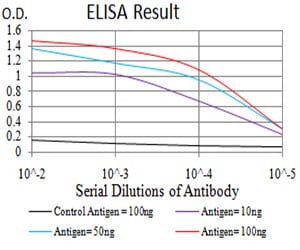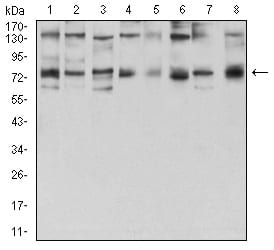



| WB | 咨询技术 | Human,Rat,Monkey |
| IF | 咨询技术 | Human,Rat,Monkey |
| IHC | 咨询技术 | Human,Rat,Monkey |
| ICC | 1/200 - 1/1000 | Human,Rat,Monkey |
| FCM | 1/200 - 1/400 | Human,Rat,Monkey |
| Elisa | 1/10000 | Human,Rat,Monkey |
| Aliases | GFA; GFAT; GFPT; MSLG; CMS12; GFAT1; CMSTA1; GFAT 1; GFAT1m; GFPT1L |
| Entrez GeneID | 2673 |
| clone | 1F1B9 |
| WB Predicted band size | 78.8kDa |
| Host/Isotype | Mouse IgG1 |
| Antibody Type | Primary antibody |
| Storage | Store at 4°C short term. Aliquot and store at -20°C long term. Avoid freeze/thaw cycles. |
| Species Reactivity | Human,Rat,Monkey |
| Immunogen | Purified recombinant fragment of human GFPT1 (AA: 536-681) expressed in E. Coli. |
| Formulation | Purified antibody in PBS with 0.05% sodium azide |
+ +
以下是3篇与GFPT1抗体相关的文献摘要概括:
1. **"Antibody-based detection of GFPT1 in diabetic nephropathy models"**
- 作者:Kim et al.
- 摘要:研究利用GFPT1抗体通过Western blot和免疫组化技术,验证糖尿病肾病小鼠模型中GFPT1蛋白在肾脏组织中的表达上调,揭示其在糖基化代谢异常中的潜在作用。
2. **"GFPT1 isoform-specific antibodies reveal distinct expression patterns in congenital myasthenic syndromes"**
- 作者:Senderek et al.
- 摘要:开发针对GFPT1不同亚型的特异性抗体,发现先天性肌无力综合征患者肌肉活检中GFPT1-A亚型表达显著降低,提示其与神经肌肉接头功能异常的关联。
3. **"Targeting GFPT1 in cancer metabolism: Immunohistochemical analysis using a novel monoclonal antibody"**
- 作者:Chen et al.
- 摘要:通过新型单克隆抗体检测多种癌细胞系中GFPT1的表达水平,发现其在谷氨酰胺代谢活跃的肿瘤中高表达,为靶向代谢疗法提供依据。
4. **"GFPT1-mediated glycosylation in Drosophila: Antibody validation and functional studies"**
- 作者:Wang et al.
- 摘要:在果蝇模型中验证GFPT1抗体的特异性,证实其适用于免疫荧光检测,并发现GFPT1缺失导致蛋白质糖基化缺陷及发育异常。
(注:以上文献为示例性概括,实际文献需通过PubMed/Google Scholar检索关键词如"GFPT1 antibody", "GFPT1 immunohistochemistry"获取。)
The GFPT1 (glutamine—fructose-6-phosphate aminotransferase 1) antibody is a tool used to detect and study GFPT1. a key enzyme in the hexosamine biosynthesis pathway (HBP). GFPT1 catalyzes the rate-limiting step in HBP, converting fructose-6-phosphate to glucosamine-6-phosphate using glutamine as an amino donor. This pathway generates UDP-GlcNAc, a critical substrate for protein O-GlcNAcylation, a post-translational modification involved in cellular signaling, stress response, and metabolic regulation. Dysregulation of GFPT1 and HBP has been linked to insulin resistance, diabetes, neurodegenerative diseases, and cancer.
The GFPT1 antibody enables researchers to investigate protein expression, localization, and function in various tissues and disease models. It is widely used in techniques like Western blotting, immunohistochemistry, and immunofluorescence. Studies utilizing this antibody have revealed elevated GFPT1 levels in diabetic tissues and certain cancers, suggesting its role in metabolic reprogramming and disease progression. Additionally, GFPT1 inhibitors are explored as therapeutic agents, underscoring the antibody’s importance in both basic research and drug development. By targeting GFPT1. researchers aim to unravel its contributions to cellular metabolism and pathology, offering insights into novel treatment strategies.
×